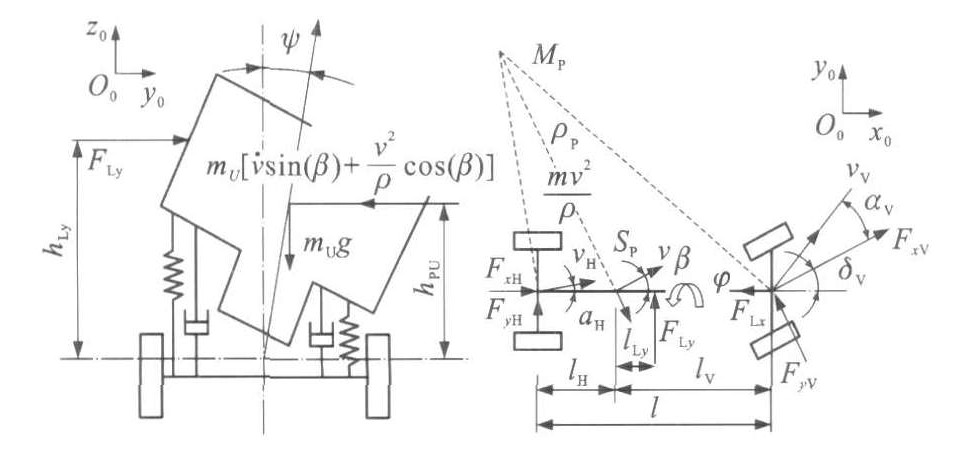3-DOF vehicle steering model and state equations based on considering air forces
Article Text (Baidu Translation)
-
摘要: 为了减小空气力的影响, 简化车辆多自由度转向动力学方程, 考虑了空气力的影响, 建立了车辆三自度转向运动的动力学模型。以质心侧偏角、横摆角、横摆角速度、侧倾角、侧倾角速度为状态变量, 以前轴转角及侧风作用力为输入, 以质心侧偏角、横摆角、横摆角速度、侧倾角为输出, 推导了车辆三自度转向运动的动力学模型的状态方程。以前轴主动转角脉冲为输入, 对状态方程的可信度进行了验证。与利用线性二自由度转向模型的仿真结果相比, 利用三自由度转向模型与其状态方程得到车辆质心侧偏角与横摆角速度的绝对值均较小, 在高速情况下, 空气力会增强车辆的不足转向特性。采用两种模型得到的车身侧向偏移均大于试验值, 但三自由度模型的仿真曲线非常接近试验曲线。可见, 三自由度状态方程可信度高。Abstract: In oder to decrease the influence of air forces, predigest the multiple-DOF steering dynamics equations of vehicle, air forces were considered, a 3-DOF steering dynamics model was proposed. The state equations of the model was induced, sideslip angle in mass vehicle center, yaw angle, yaw velocity, roll angle and roll velocity were state variables, steering angle in front axle and crosswind force were input variables, sideslip angle in vehicle mass center, yaw angle, yaw velocity, roll angle were output variables. The simulation credibility of the equations was validated by using a test vehicle with an active steering angle pulse. The simulation result with the 3-DOF model and equations was compared with that from 2-DOF steering dynamics model. Comparison result shows that the Absolute values of sideslip angle and yaw velocity from the 3-DOF model and equations are less, which indicates that air forces strengthen the lacking steering property of vehicle. The sideslip values gained by the tow models are larger than the test value, but the value gained by the 3-DOF model is closer to the test value. Obviously, the credibility of the 3-DOF equations is higher.
-
Key words:
- vehicle engineering /
- 3-DOF steering model /
- steering state equation /
- air force
-
表 1 商用车仿真参数
Table 1. Simulation parameters of commercial vehicle
参数 数值 参数 数值 m/kg 7 600 ηV 2 mU/kg 6 200 ηH 4 Imz/(kg·m2) 23 222 c1 -4.612 6 ImUx/(kg·m2) 12 946 c2 -0.584 5 ImUxz/(kg·m2) 993.2 hLx/m 1.6 l/m 3.8 hPU/m 0.916 4 lV/m 2.692 5 SV/m 0.87 v/(m·s-1) 27.78 SH/m 1.04 FzXenn/N 18 620 kV/(N·m-1) 162 100 A/m2 6.99 kH/(N·m-1) 384 200 CDx 0.64 cV/(N·s·m-1) 5 384.6 CLzV 0.18 cH/(N·s·m-1) 7 692.1 CLzH 0.23 kψV/(N·m·rad-1) 132 300 kψH/(N·m·rad-1) 44 688 -
[1] 欧阳鸿武, 高延令, 王磊. 降低厢式货车空气阻力的数值仿真研究[J]. 中国公路学报, 1998, 11(2): 113-116. doi: 10.3321/j.issn:1001-7372.1998.02.017OUYANG Hong-wu, GAO Yan-ling, WANG Lei. The numerical si mulation study on aerodynamic drag reduction of a van[J]. China Journal of Highway and Transport, 1998, 11(2): 113-116. (in Chinese) doi: 10.3321/j.issn:1001-7372.1998.02.017 [2] 李伟, 关文达, 高蔚, 等. 厢式货车空气动力学特性及减小空气阻力的风洞实验研究[J]. 中国公路学报, 1994, 7(4): 90-95. https://www.cnki.com.cn/Article/CJFDTOTAL-ZGGL404.014.htmLI Wei, GUAN Wen-da, GAO Wei, et al. Wind tunnel test research on aerodynamic characteristics and aerodynamic drag reduction of van[J]. China Journal of Highway and Transport, 1994, 7(4): 90-95. (in Chinese) https://www.cnki.com.cn/Article/CJFDTOTAL-ZGGL404.014.htm [3] 高利, 高延龄, 陈荫三. 长头厢式货车加装导流罩的风洞和道路试验研究[J]. 中国公路学报, 1995, 8(3): 50-58. https://www.cnki.com.cn/Article/CJFDTOTAL-ZGGL503.009.htmGAO Li, GAO Yan-ling, CHEN Yin-san. Wind tunnel tests and road tests of long head box van with cab roof fairing[J]. China Journal of Highway and Transport, 1995, 8(3): 50-58. (in Chinese) https://www.cnki.com.cn/Article/CJFDTOTAL-ZGGL503.009.htm [4] SI NGH S N, RAI L, PURI P, et al. Effect of moving surface on the aerodynamic drag of road vehicles[J]. Journal of Automobile Engineering, 2005, 219(9): 127-134. [5] NISUGI K, HAYASE T, SHIRAI A. Fundamental study of aerodynamic drag reduction for vehicle with feedback flow control[J]. JSME International Journal, Series B, 2004, 47(3): 584-592. doi: 10.1299/jsmeb.47.584 [6] M米奇克[德]. 汽车动力学[M]. 第二版. 北京: 人民交通出版社, 1997. [7] 谷正气, 周宇奎, 海贵春, 等. 主动四轮转向系统对高速汽车侧风稳定性的控制研究[J]. 湖南大学学报: 自然科学版, 2006, 33(1): 51-54. https://www.cnki.com.cn/Article/CJFDTOTAL-HNDX200601012.htmGUZheng-qi, ZHOU Yu-kui, HAI Gui-chun, et al. Control research on high-speed vehicle stability under side wind using active4WS[J]. Journal of Hunan University: Natural Sciences, 2006, 33(1): 51-54. (in Chinese) https://www.cnki.com.cn/Article/CJFDTOTAL-HNDX200601012.htm [8] DETTKI F. Atest methodfor the quantification of on-centre handling with respect to cross-wind[J]. Journal of Automobile Engineering, 2002, 216(4): 259-266. doi: 10.1243/0954407021529093 [9] BAKER C J, HUMPHREYS N D. Assessment of the ade-quacy of various wind tunnel techniques to obtain aerodynamic data for ground vehicles in cross winds[J]. Journal of Wind Engineering and Industrial Aerodynamics, 1996, 60(1/2/3): 49-68. [10] BAKER C J. Quantification of accident risk for road vehicles in cross winds[J]. Journal of Wind Engineering and Industrial Aerodynamics, 1994, 52(3): 93-107. [11] 徐进, 邵毅明. 风压中心位置对汽车侧风稳定性影响的虚拟试验分析[J]. 中国机械工程, 2007, 18(15): 1877-1881. doi: 10.3321/j.issn:1004-132x.2007.15.029XUJin, SHAO Yi-ming. Virtual test analysis of the effect of wind pressure center on lateral wind steer stability[J]. ChinaMechanical Engineering, 2007, 18(15): 1877-1881. (in Chinese) doi: 10.3321/j.issn:1004-132x.2007.15.029 [12] 许振华, 吴宪, 于晓军. 燃料电池汽车侧风稳定性预测[J]. 计算机辅助工程, 2008, 17(1): 25-29. https://www.cnki.com.cn/Article/CJFDTOTAL-JSFZ200801009.htmXU Zhen-hua, WU Xian, YU Xiao-jun. Prediction on cross wind stability of fuel cell car[J]. Computer Aided Engineering, 2008, 17(1): 25-29. (in Chinese) https://www.cnki.com.cn/Article/CJFDTOTAL-JSFZ200801009.htm [13] BOADA B L, BOADA MJ L, DIAZ V. Yaw moment control for vehicle stability in a crosswind[J]. Journal of Vehicle Design, 2005, 39(4): 331-348. doi: 10.1504/IJVD.2005.008466 [14] 胡建军, 李彤, 秦大同. 基于整车动力学的电动助力转向系统建模仿真[J]. 系统仿真学报, 2008, 20(6): 1577-1581. https://www.cnki.com.cn/Article/CJFDTOTAL-XTFZ200806048.htmHUJian-jun, LI Tong, QIN Da-tong. Modeling and si mulation of electric power steering system based on vehicle whole dynamics[J]. Journal of System Si mulation, 2008, 20(6): 1577-1581. (in Chinese) https://www.cnki.com.cn/Article/CJFDTOTAL-XTFZ200806048.htm [15] 王启瑞, 刘立强, 陈无畏. 基于随机次优控制的汽车电动助力转向与主动悬架集成控制[J]. 中国机械工程, 2005, 16(8): 743-747. https://www.cnki.com.cn/Article/CJFDTOTAL-ZGJX20050800L.htmWANG Qi-rui, LIU Li-qiang, CHEN Wu-wei. Integrated con-trol of automotive electrical power steering systemand suspension systembased on randomsub-opti mal control[J]. China Mechani-cal Engineering, 2005, 16(8): 743-747. (in Chinese) https://www.cnki.com.cn/Article/CJFDTOTAL-ZGJX20050800L.htm [16] 董小闵, 余淼, 廖昌荣, 等. 汽车磁流变半主动悬架自适应模糊控制研究[J]. 中国公路学报, 2006, 19(2): 210-214. https://www.cnki.com.cn/Article/CJFDTOTAL-ZGGL200602019.htmDONG Xiao-min, YU Miao, LIAO Chang-rong, et al. Research on adaptive fuzzy logic control for automobile magnetorheological semiactive suspension[J]. China Journal of Highway and Transport, 2006, 19(2): 210-214. (in Chinese) https://www.cnki.com.cn/Article/CJFDTOTAL-ZGGL200602019.htm [17] 张嗣瀛, 高立群. 现代控制理论[M]. 北京: 清华大学出版社, 2006. [18] 陈无畏, 王妍, 王启瑞, 等. 汽车电动助力转向系统的自适应LQG控制[J]. 机械工程学报, 2005, 41(12): 167-171. https://www.cnki.com.cn/Article/CJFDTOTAL-JXXB200512038.htmCHEN Wu-wei, WANG Yan, WANG Qi-rui, et al. Adaptive LQG control for the electric power steering system of an automobile[J]. Chinese Journal of Mechanical Engineering, 2005, 41(12): 167-171. (in Chinese) https://www.cnki.com.cn/Article/CJFDTOTAL-JXXB200512038.htm [19] 陈龙, 袁朝春, 江浩斌. 基于μ综合鲁棒控制的EPS车辆操纵稳定性研究[J]. 汽车工程, 2008, 30(8): 705-709. https://www.cnki.com.cn/Article/CJFDTOTAL-QCGC200808017.htmCHEN Long, YUAN Chao-chun, JI ANG Hao-bin. Astudy on the handling stability of vehicles with EPS based onμsynthesis robust control[J]. Automotive Engineering, 2008, 30(8): 705-709. (in Chinese) https://www.cnki.com.cn/Article/CJFDTOTAL-QCGC200808017.htm [20] 陈士安, 邱峰, 何仁, 等. 一种确定车辆悬架LQG控制加权系数的方法[J]. 振动与冲击, 2008, 27(2): 65-69. https://www.cnki.com.cn/Article/CJFDTOTAL-ZDCJ200802013.htmCHEN Shi-an, QI U Feng, HE Ren, et al. A method for choosing weights in a suspension LQGcontrol[J]. Journal of Vibration and Shock, 2008, 27(2): 65-69. (in Chinese) https://www.cnki.com.cn/Article/CJFDTOTAL-ZDCJ200802013.htm [21] 余志生. 汽车理论[M]. 第四版. 北京: 机械工业出版社, 2004. -





 下载:
下载:





